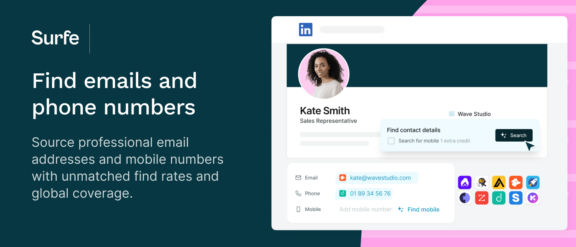How to Generate Sales Leads Without Cold Calling
Do you remember the first cold call you made?
Whether just thinking about it brings you out in a cold sweat or you’ve loved the challenge since day dot, one thing we can all agree on is that they’re pretty difficult to get right. In fact, the average cold call success rate is just 4.82%.
That doesn’t mean you should give up on cold calling forever. What it does mean is that you should rely on cold calling alongside a variety of other lead generation tactics.
That’s where this blog post comes in. Today, we’re going to be talking about how to generate B2B sales leads without cold calling. We’ll run through five different methods in detail:
You’ll come away feeling more confident in your lead generation strategies – and who knows, you might even start to enjoy cold calling more once the pressure’s off.
If that sounds good to you, let’s get going.
Cold Emailing
First things first: what is cold emailing? A cold email is an email sent to someone you don’t already have a connection with.
It’s usually considered one of the first touches in a multi-touch, multi-channel outreach strategy. The aim of the game is to get your prospect familiar with who you are and what you do – and eventually elicit a response.
Firing out random cold emails begging recipients to buy your product isn’t going to get you anywhere, though. Follow these best practices for cold email success:
Cold Emailing Best Practices
Personalization: if you want a response to your cold emails, they’ve got to resonate with your recipient. Make them feel like you understand them: their hopes, dreams and pain points (ok, maybe that last one more than anything else) and you’ll be halfway there to convincing them that yes, maybe they do need to have a chat with you about how your product can help.
Compelling subject lines: no matter how beautifully written and personalized your email is, you’re wasting your time if your subject line doesn’t entice your recipient into opening. Avoid salesy language or pressuring tactics, and be honest about the contents of the email. A good subject line will pique the recipient’s interest with a hint of what’s inside – and show how you’re going to provide value from the get-go.
Clear value proposition: speaking of value…you need to be crystal-clear and concise in explaining exactly what makes your product special. If your reader can’t understand it from a couple of sentences, all your email efforts will go to waste.
Call to action: make it clear what the recipient should do next. Asking for a response is a low-pressure way to get them to engage – or if the email’s performed well before, you could send a link for them to book a meeting through.
Tools to Help With Cold Emailing
Cold emailing can be a lot of work – but it doesn’t have to be. There are plenty of cold emailing tools you can use to automate certain parts of the process and make it a whole lot easier. For example:
Surfe: yep, that’s us! Surfe makes finding the email addresses of people you want to get in touch with super easy. Once the extension’s linked up with your LinkedIn, simply head to the profile of the person you want to find details for and hit ‘Add as contact’. Surfe will then aggregate its databases until it finds an accurate email address, and then feed the data through to a CRM of your choice. We’re nice like that.
Outreach: Outreach is an amazing tool for automating email campaigns at scale. Its AI-powered technology allows you to (among other things) send personalized email campaigns – meaning you can be sure that you’re providing value to your entire email list.

Social Selling
The modern-day B2B sales rep should be very, very familiar with social selling: the practice of using social media to sell to prospects.
If you’re not, you’re missing out: 78% of sales reps who use social selling as a lead generation tactic outsell their peers. Think of social selling as a natural way to introduce yourself to your prospects, and demonstrate the value you can add from the get-go.
First of all, you’ll need to get the right platform. If you’re in B2B sales that platform is going to be LinkedIn. Make sure your profile is well-optimized with a professional photo and an easy-to-read bio that clearly and simply explains what you do. From there, you can send connection requests to people that fit your ICP, and engage with them naturally by:
- Meaningfully interacting with their content
- Replying to their comments and contributing to discussions
- Being members of the same industry or interest groups
- Starting up a conversation in DM
Social Selling Strategies
Building authority: position yourself as an industry expert by sharing your own insights and thought leadership articles. If this sounds daunting, it doesn’t have to be: you can pick up plenty of content ideas from the conversations you have every day with prospects, and from your marketing team too.
Providing value: if you continuously provide valuable information that helps your prospects solve their problems, you’ll be thought of as a trusted advisor – which is exactly how you want people to view you.
Tools To Help With Social Selling
LinkedIn Sales Navigator: For the uninitiated, LinkedIn Sales Navigator is LinkedIn’s paid tool built for sales teams who want to build outreach lists at scale. Its powerful filtering means you can find hundreds – or maybe even thousands – of profiles that match your ICP in just a few clicks.
Surfe: Surfe works with LinkedIn Sales Navigator to cut down the time you spend finding contact data for your new list of leads. In just one click, you can use Surfe to find the email addresses and phone numbers of everyone on your list, and automatically transfer everything you find over to your CRM. That’s pretty clever, if you ask us.
Referral Incentives
You might be selling business-to-business, but at the end of the day there’s still another person at the end of the sale. And as we all know, people trust people – which is where referral incentives can come in handy.
In fact, 91% of B2B purchasers are influenced by word-of-mouth marketing. With that in mind, you’d be crazy not to get in on the hype yourself.
A B2B referral program is more than just asking your clients for referrals. Instead, it’s a formal process set up with a share link, tracking software and automatic reward send-outs. Tools like Referral Factory can help you manage this entire workflow seamlessly, from link generation to tracking and automated rewards. Looking at great referral program examples can help you design a structure that motivates participation and aligns with your business goals.
As for the benefits? Well, a referral builds trust with far, far less effort from you: like we said, people trust people, and if someone’s coming to you off the back of a recommendation it’s likely they trust that your product’s going to be good.
Referral programs can also be more cost-effective than other lead generation methods: a referral incentive is often going to be less expensive than your average cost of acquisition. Incorporating an sms marketing platform can also help you quickly notify clients of rewards and keep the referral process seamless and engaging.
Implementing An Incentive Program
To introduce an incentive program, follow these steps:
- Set up a referral link and an easy-to-fill-in sign-up page
- Decide on the reward you’ll give to your prospects: is it going to be a voucher? A delivery of baked goods? An upgraded feature or discount on their subscription?
- You’ll also want to think about the terms: do your clients only get their reward once their referral has made a purchase, or is getting them down as a lead enough?
- Promote your referral scheme by sending out regular emails, posting on social media and making sure customers can easily find their link from your website.
Once everything’s set up and the new customers are (hopefully) flying in, make sure you’re using your CRM to track referrals and make sure everyone who’s due a reward is getting one.
Networking and Industry Events
What do you think of when you think of networking? Having to introduce yourself to people you don’t know, watching their eyes drop down to your name tag and then lose interest, repeating the process all over again…if it’s something along these lines, we don’t blame you – but it’s also not what networking looks like in today’s day and age.
Events like trade shows or industry dinners can be a great way to meet prospects – and you won’t have to sell to them on the spot. Instead, focus on providing value and seeing what you can learn from other people too. The rest will come naturally.
Networking strategies
Researching events: be strategic about the events you attend. Checking out LinkedIn is a great way to see who’s going to be where – or contact the event organizers and ask if they have a list of attendees. You can also look at talk and panel topics to get a sense of how relevant the event is to your business’s value proposition.
Preparation: prepare business cards, a one- or two-sentence explanation of what you do, and any marketing materials you think could be useful for the people you speak to. If a conversation goes well, you’ll be all set to take it to the next step. For a more modern twist, you can also carry a Digital Business Card by Uniqode—a shareable link or QR code that directs prospects to your detailed contact info, LinkedIn profile, case studies, or even schedule-booking options. Additionally, the GS1 QR Code Generator lets you create scannable QR codes for business cards or materials, helping prospects quickly access your digital content.
Engagement: once you’re there, it’s no use just hiding in the corner. Make sure you’re participating in conversations and attending sessions to demonstrate your expertise. If you approach a prospect, make sure you do it from a place of curiosity about them and their pain points rather than anything else.
Follow-up: make sure you follow up with people you meet at these events to keep them warm and move them further down the sales funnel.
Your Website
Get your website right, and you’re sort of giving your business a really, really great outfit: one that shows exactly what you do and what you’re about.
You should work closely with your friends in the Marketing team on the website: feed back how your prospects receive your messaging, what type of language they use when discussing their problems, and any other insights you think should be mentioned on the site.
Your marketing team should have also put a lot of TLC into:
Lead capture forms: these should be optimized to collect exactly what you need to have an effective first conversation with a prospect – and nothing else! The less effort it takes to fill in a lead capture form, the better. SMS marketing can then be used to follow up quickly with captured leads, increasing the chances of timely engagement.
Landing pages: these should speak exactly to the pains of the customer and clearly show how your product is going to alleviate that pain. A strong landing page design ensures that this message is communicated in a clear and persuasive way.
Live chat: whether yours is a bot or has a real-life human at the end of it, live chat allows website visitors to get answers to their questions, and qualify themselves in or out.
Case studies and testimonials: social proof is the most valuable thing you can get from your customers. As we mentioned earlier, people trust people – so make sure that you’ve got plenty of real-life stories and quotes on your site for people to read through.
Educational content: things like whitepapers, eBooks and webinars can all move your prospects closer to booking a call. For even broader accessibility, consider offering text-to-speech versions of your content or audio summaries – this makes your valuable insights available to busy executives who prefer to consume content while commuting or multitasking. The more your company’s seen as a trusted source of help and advice, the easier your conversations will be later down the line.
Let’s Wrap It Up!
So there you have it: tried and trusted lead generations that don’t involve making a single cold call. Approach them from a testing and learning mindset, and eventually you’ll land on the right combination of strategies and tactics that work for you.
Just make sure you don’t get overwhelmed by the amount of new leads you have, ok?

Ready to put all your new tactics into practice?
Better download Surfe – stat. It’ll help you find all the contact data you need from LinkedIn in just a couple of clicks. Oh, and did we mention it’s free?
FAQs
How To Generate Leads Organically?
You can generate leads organically by using a combination of tactics, including social selling, networking and attending events, and having a strong marketing presence online. By positioning yourself as a trusted advisor and industry expert, you’ll have people coming to you to solve their problems. Eventually, you want to build an organic inbound lead machine that reduces your reliance on expensive or time-consuming outbound strategies.
How Do You Find Leads Fast?
LinkedIn Sales Navigator is an excellent tool when it comes to finding leads quickly. You can use its powerful filtering capabilities to quickly build a list of profiles that closely match your ICP. Then, use Surfe to pull their contact data in just one click – and feed it all through to your CRM of choice. You’re ready to go!
Can You Do Sales Without Cold Calling?
Yes, it is possible to have a sales role that doesn’t involve cold calling: you just need to focus on other lead generation strategies. This might involve cold emailing or messaging on social media, or perhaps you prefer to build your online presence and focus on organic opportunities. It’s most likely to be a combination of the above, although the exact approach will vary depending on your business.
How To Generate Leads In Sales?
You can generate leads in sales by using a combination of the following lead generation tactics:
- Cold calling
- Cold emailing
- Social selling
- Attending events and networking
- Optimizing your website
- Implementing a referral incentive program









